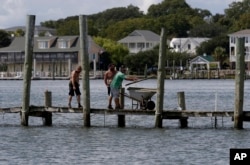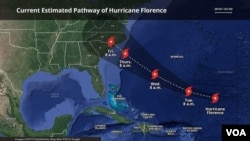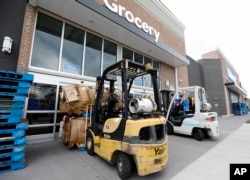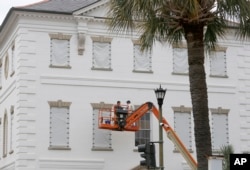President Donald Trump said Tuesday that the White House was "as ready as anybody has ever been" as a killer hurricane moved closer to making a direct hit on the southeastern U.S. coast.
Hurricane Florence, an extremely dangerous Category 4 storm, was producing top sustained winds of 220 kilometers per hour (137 mph). Forecasters said they expected the storm to be at least that strong when it slams into the Carolinas late Thursday or early Friday.
There was a chance Florence could shift to the north, putting Virginia, Maryland, Delaware and Washington, D.C., in its direct path.
"Any amount of money, whatever it takes, we're going to do it," Trump said, as he talked about relief efforts with federal disaster officials.
The president signed declarations of emergency Tuesday for the Carolinas and Virginia, a move that freed up federal money and resources. And he had advice for coastal residents.
"I would say everybody should get out. It's going to be really, really bad along the coast," Trump said.
As of late Tuesday afternoon, more than 1 million people along the coasts of North and South Carolina and southern Virginia had fled. Gas stations were running out of fuel. Those who were defying mandatory evacuation orders were leaving store shelves bare of emergency supplies.
North Carolina Gov. Roy Cooper had a direct message for residents who had decided to stay put.
"This storm is a monster. It's big, and it's vicious," he said. "The waves and wind this storm may bring are nothing like you've ever seen. Even if you've ridden out storms before, this one is different. Don't bet your life on riding out a monster."
Experts said this could be the strongest storm to hit the Carolina coast in more than 60 years.
Forecasters were particularly concerned that Florence was expected to be a slow-moving storm that could linger along the coast and inland for days, dumping massive amounts of rain on parts of the U.S. already saturated.
As much as 114 centimeters (45 inches) of rain was expected to fall on parts of North Carolina. The soaked ground and fierce winds could bring down trees and power lines and knock out electricity for weeks.
Parts of the southeastern coast that were not under hurricane warnings were under tropical storm or storm surge warnings, meaning life-threatening floods were possible.














